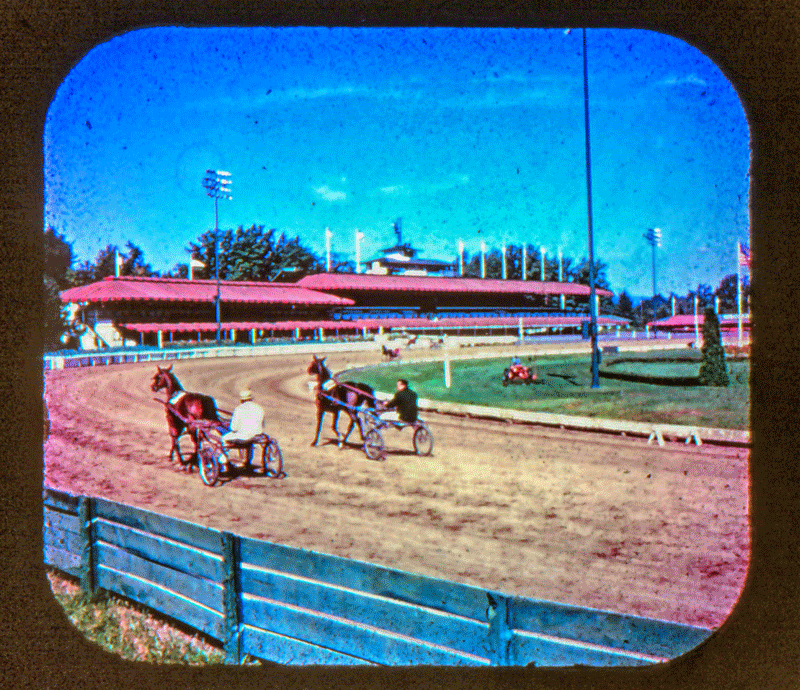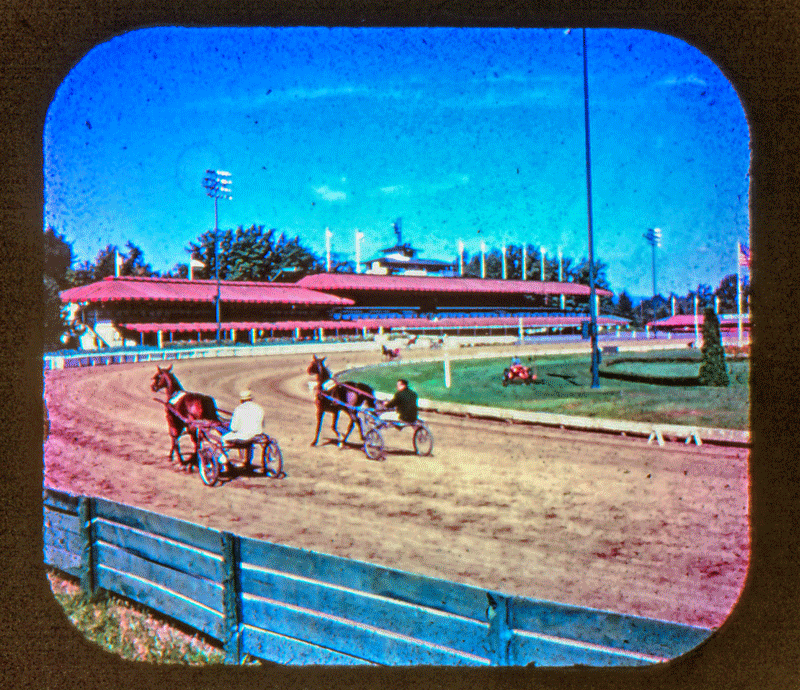Okay. I’ve got my “new-to-me” Nikon EM cameras – which I’ve combined in a c’est schisse format to hopefully create stereo photos, and now it’s time to test out my photographic plans.
Work with me on this.
First, take a look at the frames from this vintage 1960’s-era View-Master photo set.
 |
 |
Well now. These are the left and right pictures from a View-Master reel of photos from Lake George and the Adirondacks. This image was credited as “Trotter’s Track, Saratoga Springs.” You don’t suppose they mean Saratoga Harness, do you? (Yes, I know it’s officially “Saratoga Casino Hotel,” but they’re not paying me to call it that, so it’s Saratoga Harness as far as I’m concerned).
My hypothesis is that these photos were captured with a special View-Master camera that takes stereo photographs. The film was developed and duplicated into Kodachrome prints, which were mechanically pressed – seven pairs to a reel – into this View-Master disc. And even though the disc itself went through various companies and manufacturers – Sawyer’s, GAF, who knows who else – the same picture was used over and over again. So this may have come from the 1950’s or the 1960’s, I’m not sure exactly when.
I can, however, determine that the picture is definitely of age – for example, check out the wooden fences in the picture, the harness track now uses a chain-link fence to surround the track. And look at the grandstand – not a racino anywhere to be spotted.
So I took the two stereo pictures you see there … and combined them into a “magic motion” 3D print.
So there is definitely some 3D action going on here … but the separation isn’t that noticeable. You can see some depth between the fence and the trotters, and maybe some depth between the trotters and the grandstand, but it’s very subtle.
Thus begins my latest trick.
Over the past few weeks, I’ve acquired two vintage Nikon EM cameras – among the film cameras Nikon produced, these are the most bare-bones units in existence – and fitted both cameras with 50mm f/1.8 prime lenses. Then, I added two working Nikon MD-E film winders to each camera, so that the cameras can take pictures at a blistering two frames per second.
And from there … I bolted both cameras onto a special tripod extension. What I plan to do is introduce stereo photography with mono cameras – or, depending on how far apart I space the film, hyperstereo photos.
Maybe I can achieve something more potent with my new camera setup. Since I don’t have a way to develop Kodachrome, I’ll use another slide film – Fuji Velvia 100 – and pack that into two cameras.
So my setup looks something like this.
Both cameras employ a winding mechanism (that’s the attachment to the bottom of each camera) that will advance the film after the shutter has been engaged. One of the winders may have gotten stuck, but a quick flip of the ON/OFF switch and everything is back to normal.
By the way, here’s what it looks like from my vantage point.
I took a few shots at this angle, with the cameras spaced apart like so. Both cameras were loaded with Kodak Portra 800 film, with a maximum of 36 shots per roll.
This is how it looks when the pictures are assembled.
Here’s a shot of the track photographer capturing the winning horse last Sunday – a horse named I’m Not Vanilla, who took the fourth race that afternoon.
And I took some more shots of the track.
Okay, a few notes.
These photos were taken in automatic exposure mode, so if I used the rapid-fire winder, one camera would advance slower than the other. For better synchronization, I should push the shutters simultaneously every time and not rely on the camera’s 2 frames per second reload.
Also, I need two manual shutter cables. I cannot limit myself to using both hands for this camera, which would leave me with no hands to operate a different camera. This will be very important in a month or so. Trust me.
And one of these cameras is seriously over-exposing the film, while the other is seriously under-exposing the film. And it’s most noticeable in sky shots. One frame has distinct clouds, the other has none. I need symmetry, not individuality. And I think this is mostly tied in with the automatic shutter, one of these cameras is guessing high and the other is guessing low. I may need to use the EM’s standard shutter speed of 1:90 and open the f-stops to compensate.
But all in all … I see where things went right with these shots, and where they went wrong.
At this point in time, I make the adjustments and I move on.
That’s part of experimentation, isn’t it? 😀







Neat I guess but not easy on old eyes!
LikeLike
I applaud your determination. I agree with John though, those are tough on my 70 year old eyes.
LikeLike
Same; the flickering is disturbing.
Also the distance between the lenses puts you in “hyper stereo” mode; if you could get the cameras closer together it would be a more realistic result. The distance between lenses on actual stereo cameras is set to simulate the distance between human eyes so the left/right vantage points are as close to Realistic (famous stereo camera) as possible.
LikeLike
Yeah, I think you’re right on the natural versus hyperstereo setup. I’m also going to try to shoot my next test in a manual mode (the EM has a 1:90 setting for manual) and see if that eliminates the overexposure / underexposure that these cameras are doing. If this doesn’t work, I may get a couple of Nikon D70’s online and use them instead.
LikeLike
Interesting project Chuck. I work at a company in Troy doing R&D for transportation purposes. We do some stereo and hyperstereo projects. I’d love to have you come in and discuss your work with me.
LikeLike